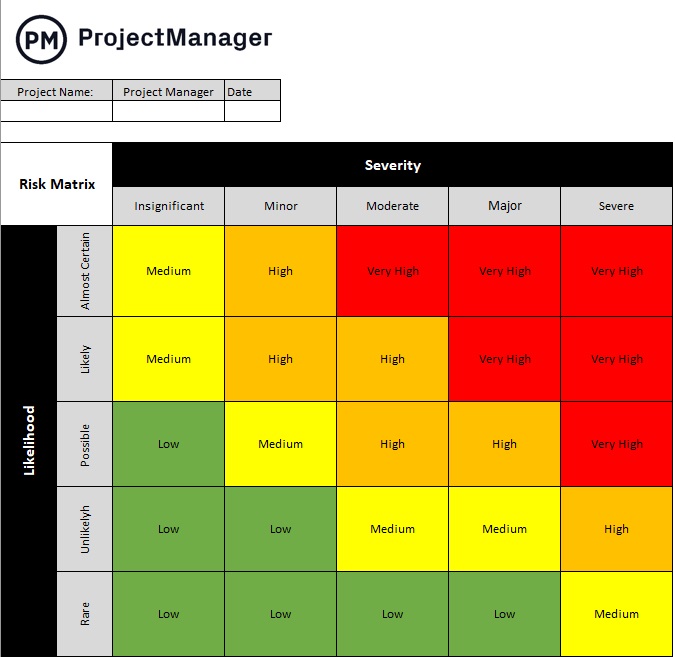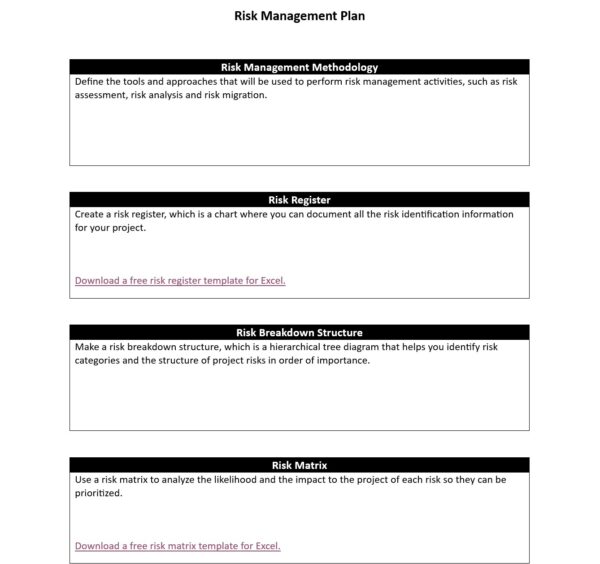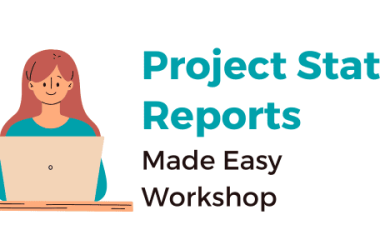You identify them, record them, monitor them and plan for them: risks are an inherent part of every project. Some project risks are bound to become problem areas—like executing a project over the holidays and having to plan the project timeline around them. But there are many risks within any given project that, without risk assessment and risk mitigation strategies, can come as unwelcome surprises to you and your project management team.
That’s where a risk management plan comes in—to help mitigate risks before they become problems. But first, what is project risk management?
What Is a Risk Management Plan?
A risk management plan defines how the project’s risk management process will be executed. That includes the budget, tools and approaches that will be used to perform risk identification, assessment, mitigation and monitoring activities.
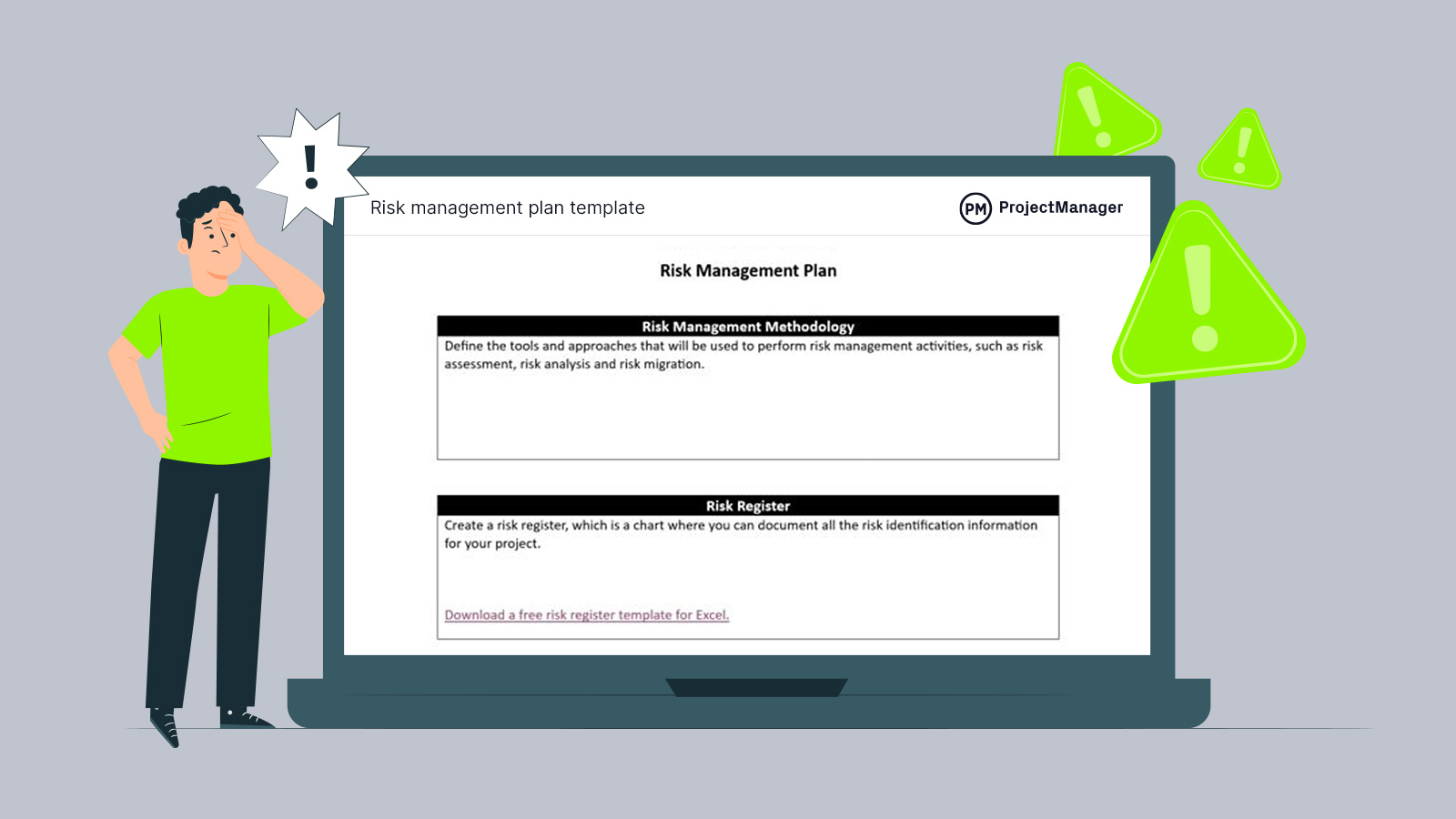
Get your free
Risk Management Plan Template
Use this free Risk Management Plan Template for Word to manage your projects better.
A risk management plan describes all the activities that will be taken throughout the process of managing project risks, which is divided into four main phases:
- Risk Identification: The first step to managing project risks is to identify them. The risk management plan explains the tools and data sources such as information from past projects or subject matter experts’ opinions to estimate all the potential risks that can impact the project.
- Risk Assessment: Once the project risks are identified, they need to be prioritized by looking at their likelihood and level of impact. In most cases, the risk management plan includes a risk assessment matrix to do so.
- Risk Mitigation: Now it’s time to create a contingency plan with risk mitigation actions to manage your project risks. You also need to define which team members will be risk owners, responsible for monitoring and controlling risks.
- Risk Monitoring: Risks must be monitored throughout the project life cycle so that they can be controlled. The risk management plan describes the procedures, tools and techniques to monitor the occurrence and mitigation of project risks.
Even one risk can jeopardize the entire project plan. There isn’t usually just one risk per project, either; there are many risk categories that require assessment and discussion with stakeholders. That’s why risk management needs to be both a proactive and reactive process that is constant throughout the project life cycle.
For example, it’s easy to create a risk register using online project management software. Use the list view on ProjectManager to capture all project risks, add their priority level and assign a team member to own identify and resolve them. Better than to-do list apps, you can attach files and tags and monitor progress. Track the percentage complete and even view risks from the project menu. Keep risks from derailing projects by signing up for a free trial of ProjectManager.
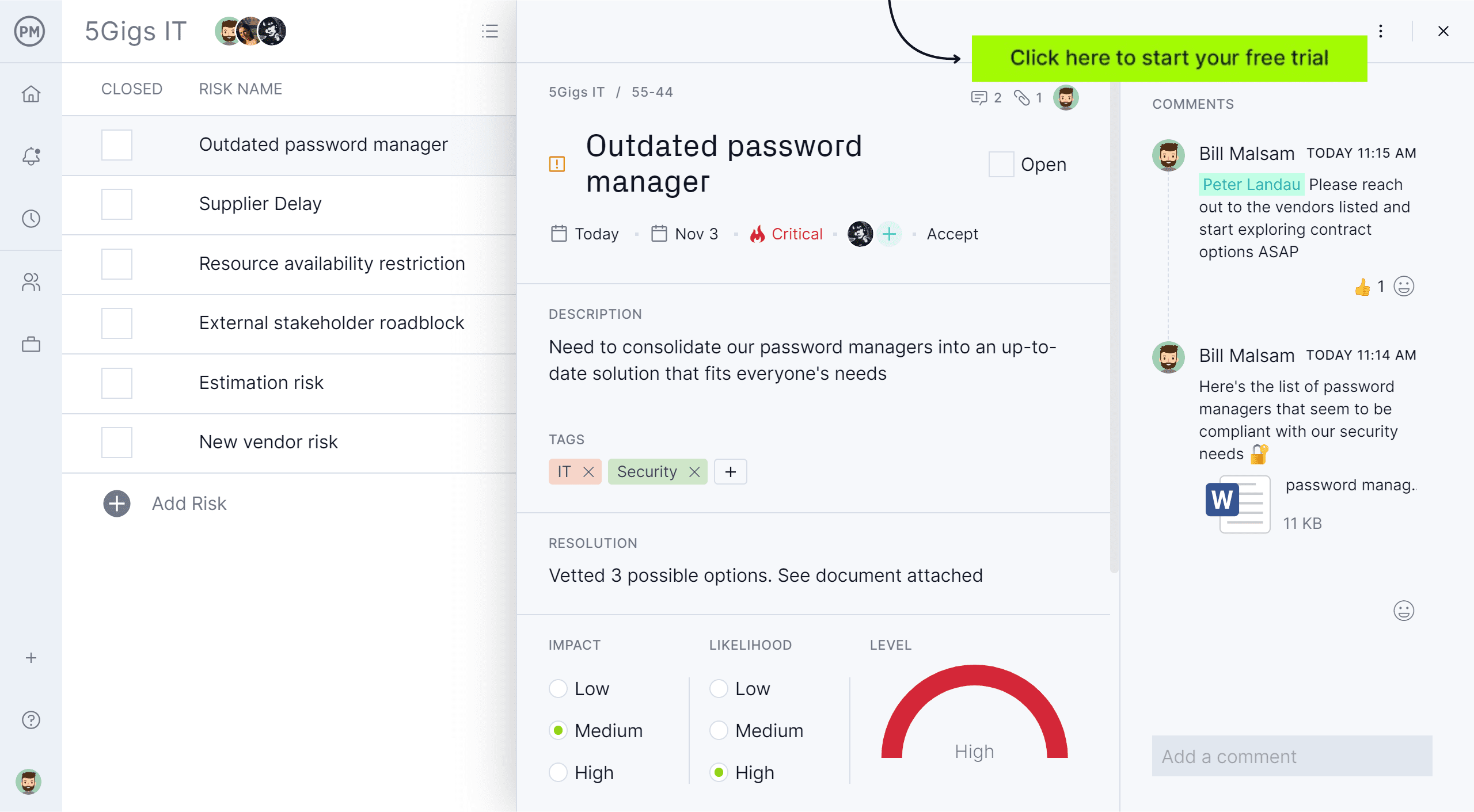
What Should Be Included in a Risk Management Plan?
Making a risk management plan is essential for identifying, analyzing and responding to risks that could affect a project’s success. For a risk management plan to be effective, it should include certain key components. A risk management plan usually includes the following sections.
Risk Management Methodology
Risk management methodology is a systematic approach for identifying, assessing, managing and monitoring risk within a project. It provides a structured framework for decision-making and helps organizations minimize the negative impacts by maximizing opportunities. Risk management methodology will define the tools and approaches that will be used to perform risk management activities such as risk assessment, risk analysis and risk mitigation strategies. It includes the following:
- Risk Governance: The framework and processes used to identify, assess, manage and communicate risks.
- Risk Tolerance: The level of risk that an organization or project is willing to accept in pursuit of its goals.
- Risk Reporting: The process of communicating information about identified risks, their assessments and the status of risk management activities to stakeholders.
- Risk Assessment Methods: Risk assessment methods can be broadly categorized into qualitative and quantitative approaches. The former include a risk matrix, SWOT analysis, interviews, brainstorming, etc. The latter includes probability and impact assessment, decision tree analysis, cost-benefit analysis, etc.
- Risk Mitigation Strategy: The plans and actions put in place to reduce the likelihood or impact of risks within a project.
Roles and Responsibilities
The risk management team members have responsibilities as risk owners. They need to monitor project risks and supervise their risk response actions.
These roles must be clearly defined for effective risk identification, assessment and mitigation. Every role on the team will have specific responsibilities, from the project manager to the risk management team, risk owner, stakeholders, subject matter experts, finance and accounting team, quality assurance team, change control board and communication manager.
Risk Response Plan
A risk response plan is a project management document that explains the risk mitigation strategies that will be employed.
Its purpose is to minimize the likelihood and impact of negative risks while maximizing opportunities. This is an action plan that outlines what is to be done and who will be doing it.
Risk Management Budget
Have a section to identify the funds required to perform risk management activities.
This financial plan will allocate resources specifically for identifying, assessing and managing risks within a project. The budget ensures that there is enough funding available to implement risk management strategies and mitigate negative impacts on project objectives.
Risk Register
A risk register is a chart to document the risk identification information. It serves as a centralized repository that captures and tracks all identified risks throughout the project life cycle. This provides a comprehensive overview, systematic tracking, prioritization of critical risks, stakeholder engagement and more.
Risk Breakdown Structure
This is a chart that identifies risk categories and the hierarchical structure of project risks. It provides a structured risk identification, which makes it easier to analyze and manage risks. The risk breakdown structure also provides clear definitions and descriptions of risks at various levels, which helps the team to understand the nature and source of each risk. Risks can be prioritized more effectively, too.
Risk Assessment Matrix
A risk assessment matrix allows teams to analyze the likelihood and the impact of project risks so they can prioritize them.
Using a risk assessment matrix provides a visual representation of the relationship between the likelihood of risks occurring and their potential impact. It helps teams to focus on critical risks by categorizing them into different levels. The risk assessment matrix also facilitates communication to ensure everyone is aligned on risk prioritization.
How to Make a Risk Management Plan
For every web design and development project, construction project or product design, there will be risks. That’s the nature of project management. But that’s also why it’s always best to get ahead of them as much as possible by developing a risk management plan. We’ve outlined the steps to make a risk management plan below.
1. Risk Identification
Risk identification occurs at the beginning of the project planning phase, as well as throughout the project life cycle. While many risks are considered “known risks,” others might require additional research.
Create a risk breakdown structure to identify project risks and classify them into risk categories. You can do this by interviewing all project stakeholders and industry experts. Many project risks can be divided into risk categories, like technical or organizational, and listed out by specific sub-categories like technology, interfaces, performance, logistics, budget, etc. Additionally, create a risk register to share with everyone interviewed for a centralized location of all known risks revealed during the identification phase.
2. Risk Assessment
In this next phase, review the qualitative and quantitative impact of the risk—like the likelihood of the risk occurring versus the impact it would have on the project—and map that out into a risk assessment matrix
First, you’ll do this by assigning the risk likelihood a score from low probability to high probability. Then, map out the risk impact from low to medium to high and assign each a score. This provides an idea of how likely the risk is to impact project success as well as how urgent the response will need to be.
To make it efficient for all risk management team members and project stakeholders to understand the risk assessment matrix, assign an overall risk score by multiplying the impact level score with the risk probability score.
3. Create a Risk Response Plan
A risk response is the action plan taken to mitigate project risks when they occur. The risk response plan includes risk mitigation strategies to mitigate the impact of project risks. Doing this usually comes with a price—at the expense of your time or your budget. So you’ll want to allocate resources, time and money for your risk management needs before creating the risk management plan.
4. Assign Risk Owners
Next, assign a risk owner to each project risk. Those risk owners become accountable for monitoring the risks assigned to them and supervising the execution of the risk response if needed.
Related: Risk Tracking Template
When creating the risk register and risk assessment matrix, list out the risk owners, that way no one is confused as to who will need to implement the risk response strategies once the project risks occur, and each risk owner can take immediate action.
Be sure to record the exact risk response for each project risk with a risk register and have the risk response plan approved by all stakeholders before implementation. That way, there’s a record of the issue and the resolution to review once the project is finalized.
5. Understand Your Triggers
This can happen with or without a risk already having impacted the project—especially during project milestones as a means of reviewing project progress. If they have, consider reclassifying those existing risks.
Even if those triggers haven’t been met, it’s best to come up with a backup plan as the project progresses—maybe the conditions for a certain risk won’t exist after a certain point has been reached in the project.
6. Make a Backup Plan
Consider your risk register and risk assessment matrix a living document. Project risks can change in classification at any point, and because of that, come up with a contingency plan as part of the process.
Contingency planning includes discovering new risks during project milestones and reevaluating existing risks to see if any conditions for those risks have been met. Any reclassification of a risk means adjusting your contingency plan.
7. Measure Your Risk Threshold
Measuring your risk threshold is all about discovering which risk is too high and consulting with project stakeholders to consider whether or not it’s worth it to continue the project—worth it whether in time, money or scope.
Here’s how the risk threshold is typically determined: consider your risks that have a score of “very high”, or more than a few “high” scores, and consult with your leadership team and project stakeholders to determine if the project itself may be at risk of failure. Project risks that require additional consultation are risks that have passed the risk threshold.
To keep a close eye on risks as they raise issues in the project, use project management software. ProjectManager has real-time dashboards embedded in our tool, unlike other software that require teams to manually build them. We automatically calculate the health of projects, checking if teams are on time or running behind. Get a high-level view of how much you’re spending, progress and more. The quicker the risk is identified, the faster you can resolve it.
Free Risk Management Plan Template
This free risk management plan template will help prepare your team for any risks inherent in the project. This Word document includes sections for your risk management methodology, risk register, risk breakdown structure and more. It’s so thorough, you’re sure to be ready for whatever comes your way. Download the template today.
Best Practices for Maintaining Your Risk Management Plan
Risk management plans only fail in a few ways: incrementally because of insufficient budget, via modeling errors or by ignoring your risks outright.
Your risk management plan is constantly evolving throughout the project life cycle, from beginning to end. So the best practices are to focus on the monitoring phase of the risk management plan. Continue to evaluate and reevaluate your risks and their scores, and address risks at every project milestone.
Project dashboards and other risk-tracking features can be a lifesaver for maintaining your risk management plan. Watch the video below to see just how important project management dashboards, live data and project reports can be for keeping projects on track and budget.
In addition to routine risk monitoring, at each milestone, conduct another round of interviews with the same checklist you used at the beginning of the project, and re-interview project stakeholders, risk management team members, customers (if applicable) and industry experts.
Record their answers, adjust the risk register and risk assessment matrix if necessary, and report all relevant updates of your risk management plan to key project stakeholders. This process and level of transparency help identify any new risks to be assessed and shows if any previous risks have expired.
How ProjectManager Can Help Your Risk Management Plan
A risk management plan is only as good as the risk management features you have to implement and track them. ProjectManager is online project management software that lets you view risks directly in the project menu. You can tag risks as open or closed and even make a risk matrix directly in the software. You get visibility into risks and can track them in real time, sharing and viewing the risk history.
Tracking & Monitor Risks in Real Time
Managing risk is only the start. You must also monitor risk and track it from the point that you first identified it. Real-time dashboards provide a high-level view of slippage, workload, cost and more. Customizable reports can be shared with stakeholders and filtered to show only what they need to see. Risk tracking has never been easier.
Risks are bound to happen no matter the project. However, if you have the right tools to better navigate the risk management planning process, you can better mitigate errors. ProjectManager is online project management software that updates in real time, giving you all the latest information on your risks, issues and changes. Start a free 30-day trial and start managing your risks better.
The post How to Make a Risk Management Plan (Template Included) appeared first on ProjectManager.

